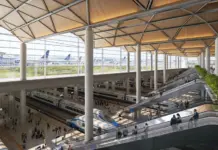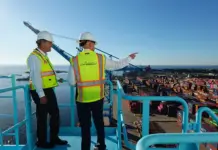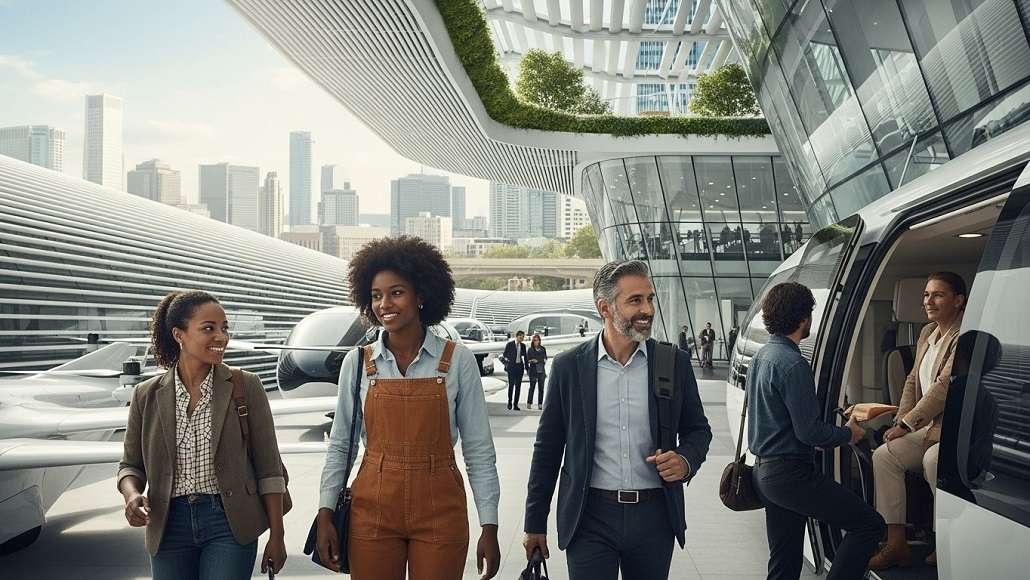The rise of Urban Air Mobility and the terminal of the skies in the quickly changing cities of the 21st century is a paradigm shift that will change how people and products move around cities. UAM is no longer just a science fiction idea; it’s already drawing billions of dollars in investment and a lot of attention from regulators, industry experts, and the public. The idea of air taxis, self-driving drones, and vertically integrated aerial transit networks is causing a lot of discussion about how cities need to change their infrastructure, rules, and business ecosystems to work well with this new way of getting around. As the race heats up, especially in Asia’s growing and quickly urbanising cities, stakeholders need to think about what Urban Air Mobility and the terminal of the sky really need, from scalable infrastructure to regulatory readiness and new ideas for terminal design.
What infrastructure do air taxis and drones need?
Urban Air Mobility and the terminal of the skies call for a complete overhaul of city infrastructure, more than what city planners have planned for now. Morgan Stanley’s 2022 research says that the worldwide UAM market may be worth up to $1 trillion by 2040 and more than $9 trillion by 2050. Most of the early growth will come from big cities in Asia and North America. Air taxis, eVTOL (electric vertical takeoff and landing vehicles), and self-driving drones will all need a network of “vertiports” that do more than just provide landing pads. These need to be placed in the best places to make them as easy to get to and as useful as possible, which is often in densely populated areas where space is limited.
NASA and the European Union Aviation Safety Agency have found that a city with ten million people could need 80 to 100 vertiports to support a high UAM density. Each vertiport would need to have fast charging stations, advanced air traffic management interfaces, maintenance bays, and places for passengers to get on and off. The World Economic Forum said in 2023 that charging and energy infrastructure alone might cost approximately 35–40% of the money needed to make UAM work in a big city. Also, these vertiports need to be perfectly linked to ground transportation options like buses, metros, and last-mile autonomous shuttles to make sure that the urban mobility ecology is completely integrated.
The problem with infrastructure goes beyond the physical. UAM will require improvements to the smart grid to handle the huge, localised electrical loads from fast-charging eVTOL (electric vertical takeoff and landing vehicles) fleets, as well as strong digital infrastructure to keep track of real-time flight trajectories, weather threats, and emergency response. A city-wide network of sensors and communications relays that works with next-generation air traffic management (ATM) systems will be very important. The Federal Aviation Administration’s UTM (Unmanned Aircraft System Traffic Management) pilot programs in the US are an early example, although they are still looking at how well the system can handle the high population density in Asian cities.
What Terminal Design Means for UAM Integration
Architects, civil engineers, and operators all have a big problem when it comes to adding Urban Air Mobility and the terminal of the skies to existing cityscapes. UAM terminals, sometimes known as “vertiports” or “skyports,” are different from standard airport terminals that are built for fixed-wing aircraft on large sites. They need to be small, modular, and very automated, and they frequently fit in with rooftops, parking buildings, or reused city property. A top consulting firm, Roland Berger, says that by 2030 there might be more than 300 urban vertiports around the world, with roughly half of them in Asia.
The terminal of the sky must put the passenger experience first by making sure that security, boarding, and transfer zones are as smooth and safe as possible. At the same time, these facilities must meet specific needs, such as quick battery changes or charging for eVTOL aircraft, strong noise and emissions restrictions, and better vertical and horizontal connections to multimodal ground networks.
Since 2022, the Civil Aviation Authority and the Land Transport Authority in Singapore have worked with Volocopter to set up Asia’s first planned public air taxi routes. These routes will have prototype vertiports with dynamic wayfinding, biometric access controls, and AI-powered scheduling platforms. These terminals are made to handle a lot of traffic. The National University of Singapore ran simulations that showed that an urban vertiport with only 500 square meters of space could handle more than 200 UAM flights per day if the turnaround time was quick and traffic was managed automatically. Safety is the most important thing. Terminals must have fail-safe fire suppression, real-time weather monitoring, and secure physical separation between passengers and active landing areas.
The terminal of the skies must also be able to grow in the future. Operators can change the number of pads or the flow of passengers as UAM grows thanks to flexible design, modular building methods, and digital twin integration. The partnership between London City Airport and Skyports has shown how existing transit hubs may be converted with little work for eVTOL operations. This is a model for Asia’s crowded cities, where space is even more limited.
Regulatory and Business Readiness in Asia
Urban Air Mobility and the terminal of the skies could change Asia more than any other region. This constant urbanisation has led to chronic traffic jams and air pollution, which has created a huge need for alternative ways to get around. The Urban Mobility Readiness Index 2023 by Oliver Wyman says that cities like Singapore, Seoul, and Tokyo are some of the finest places in the world for early UAM adoption because they have excellent digital infrastructure, government backing, and regulatory initiatives that look ahead.
Regulatory readiness, on the other hand, is still a difficult problem. Countries in Asia are racing to come up with common rules for eVTOL certification, integrating eVTOLs into the airspace, and keeping passengers safe. The Civil Aviation Administration of China put out its initial rules for UAM operations in 2022. It is also helping EHang with its autonomous drone experiments in Guangzhou, where more than 2,000 commercial test flights have taken place without any safety issues being recorded so far. Japan’s Ministry of Land, Infrastructure, Transport, and Tourism is working with Joby Aviation and other eVTOL makers to make commercial flights to the Osaka World Expo in 2025.
Even though these improvements have been made, commercial readiness is still not consistent. Asia’s regulatory environment is very different from one country to the next, and local governments have different goals. There are also problems with public acceptance. Airbus’s Voom service, which started in São Paulo and Mexico City and then tried to expand to Asia, learnt the hard way how important it is to follow the rules and get the community on board. It stopped operations in 2020 because of pandemic-related problems and inconsistent regulation.
Still, there is a huge need for business. According to KPMG’s “Future of Urban Air Mobility” report from 2023, Japan, South Korea, China, and Singapore will be the leaders in the Asia-Pacific area, which might account for 45% of global UAM passengers by 2035. Both new and old aerospace companies are spending a lot of money on demonstration projects, fleet investments, and complex public engagement efforts to gain trust and get people to use their products.
Today, we are shaping the skies of tomorrow.
Urban Air Mobility and the terminal of the skies are changing the way people think about getting about in cities. This new way of thinking is already affecting infrastructure investment, legislative discussion, and business strategy in Asia and other parts of the world. To make the promise of safe, seamless, and long-lasting aerial mobility a reality, we need to act quickly and in a coordinated way on many fronts. These include building scalable vertiport networks, developing compact and flexible terminal designs, and making sure that regulatory frameworks protect public safety without stifling innovation.
Urban Air Mobility and the terminal of the skies might either be a fantasy or become the basis for how people live in cities in the future. Cities that are ready to spend money, come up with new ideas, and work together could see huge benefits in terms of economic growth, sustainability, and connecting people. Now is the moment to get ready for Urban Air Mobility and the end of the skies. Those who act courageously will shape not only the skylines but also the very heart of urban life in the 21st century.












